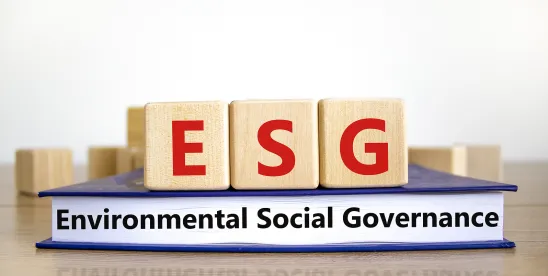I. Introduction
With environmental, social, and governance (ESG) principles garnering increased attention in corporate circles in recent years, there has been an accompanying rise in demand for analytical products that evaluate companies’ ESG performance. ESG “ratings” — or “scores,” as they are often referred to — offer one popular means of measuring this performance through a detailed assessment of a company’s operations and governance practices.[1] These products have taken on additional significance in financial markets as asset managers and other market participants seek to offer clients access to investment indices and model portfolios based on such ratings.
ESG ratings provide an account of a company’s performance across several nonfinancial metrics, such as environmental impact, diversity, equity, and inclusion (DEI), and corporate governance. Providers of ESG ratings compile data to create holistic performance scores. In turn, these ratings can serve as valuable tools to compare the performance of companies, guide investment strategies, and inform other ESG-related decisions.
Yet there are substantial reasons to question the utility of ESG ratings. Different ESG ratings may convey dissimilar information depending on the provider and methodology employed, and it is unclear whether these ESG ratings can serve as meaningful indicators of financial and operational outcomes. Additionally, the rapid and ongoing changes to ESG writ large (e.g., novel regulations, judicial and political friction, etc.) have also created complications for the ESG ratings industry, as the landscape for ESG ratings products is being continually reshaped.
This article analyzes the salience of ESG ratings and considers certain methodologies underlying their calculation for professionals. The article also discusses various issues concerning ESG ratings and provides key takeaways about the prudent deployment of ESG ratings products.
II. ESG Ratings: Purposes and Uses
ESG ratings are intended to measure “ESG quality,” an undefined term that has been the subject of much debate among ratings professionals. Two competing conceptions of this concept that have emerged include one focused on measuring a corporation’s impact on “Stakeholders” and another focused on measuring the same pertaining to “Shareholders.”
Stakeholders: One view proposes ESG ratings as a measure of a company’s impact on the welfare of its stakeholders, such as employees, customers, communities, and the environment. This perspective also measures ESG performance in relation to the degree to which a company considers ethical issues. As such, “ESG quality” concerns the external byproducts of a company’s operations; companies with the largest positive contributions to society should score highly, while those generating harmful external effects would score poorly. This perspective is often understood colloquially but has proven difficult to quantify empirically.
Shareholders: In corporate circles, ESG quality is often defined in terms of materiality (i.e., information that a reasonable investor would view as significant for their decision-making). Here, ESG performance is measured by evaluating a company’s efforts to mitigate a set of financially material ESG risk factors. These mitigation efforts, in turn, are presumed to generate greater returns for a company’s shareholders. Thus, companies that effectively mitigate these risks achieve a higher ESG quality score, while those that ignore external costs score poorly. Because of its basis in materiality, this framing has been promoted in boardrooms where directors and managers have long applied a materiality standard to their SEC disclosures. This second perspective on ESG quality is the preeminent view adopted by ratings providers to date.
Several types of market participants use ESG ratings, each for different purposes:
Companies: Businesses may wish to validate the strength of their internal ESG commitments, understand their exposure to ESG-related regulations or liabilities, or signal to stakeholders that their business prioritizes ESG. The use of third-party evaluators may also provide substantive assurance for executives on ESG-related issues.
Institutional Investors: ESG ratings can play an important role in guiding investments at institutions that invest on behalf of clients. Managers may look to ESG performance as an indicator of financial performance or to evaluate a company’s exposure to social and environmental risks. Managers who are interested in the composition of their holdings regarding ESG factors may also employ ESG ratings to guide their investment strategies, either to bring an investment product to market or in pursuit of personal values.
Retail Investors: Non-professional investors often invest in accordance with personal values, but seldom individually consume sophisticated information such as companies’ public disclosure statements. ESG ratings can help bridge this divide by broadcasting complex corporate governance information in a digestible manner for a wider audience.
In general, investors’ appetite for ESG has shown consistent growth. Although the 12% growth rate observed between 2016 and 2020 has diminished, the number of global ESG-related assets under management is set to exceed $40 trillion by 2030.[2] In the US alone, there are over $8 trillion of these assets, accounting for about 12.5% of all investments.[3] Surveys of investor confidence in ESG are another indication that interest in ESG may persist. Among individual investors and financial professionals globally, 75% of respondents to surveys reported a current interest in pursuing sustainable or ESG-related strategies for their portfolios.[4] A majority of these respondents (54%) further anticipate increasing their stake in sustainable investments in the coming years as well.[5]
A number of institutional investors and other financial professionals have cited long-term financial returns as the primary reason for incorporating ESG into their management strategies.[6] Indeed, certain scholarship supports that ESG factors — and ESG ratings, in particular — can serve as valuable indicators of a company’s financial performance.[7] Saliently, some recent research has shown that the stock returns of companies with higher ESG ratings can outperform those with lower scores over long time horizons.[8] Analogous studies have also found correlations between ESG scores and other positive performance statistics like lower financial volatility and the effective allocation of capital from investments.[9] These studies, and others, can help substantiate the connection between a company’s performance on ESG ratings indices and its operational outcomes, suggesting that ESG ratings may present valuable material information.
Yet there is still considerable hesitation around the use of ESG, especially amid recent tumult. Studies by Morningstar have found that ESG-related investment has decelerated since 2020 and even recorded instances of net outflows of capital from 2022 to 2023.[10] ESG-related equity funds have also underperformed their conventional peers during the same period, raising concerns for investors in the immediate future.[11] In the United States, this hesitation is particularly evident among professional investors, with at least one recent study reporting that only 38% of institutional investors in the US have adopted ESG into their financial strategies — a stark contrast to investor blueprints in Europe (94%) and Asia (86%).[12] This divergence could be attributable to the recent political polarization around ESG principles or delays in the promulgation of SEC rules and other legislation.[13]
Other industry-wide concerns about the reliability and implementation of ESG ratings information exist as well, as discussed in more detail in the following sections.
III. ESG Ratings Methodologies: Key Considerations
Each ESG ratings provider has created a unique scoring system, or methodology, for computing company ratings. These methodologies aggregate data relating to the oversight practices, internal policies, and operational results of a company’s ESG-related activities.
ESG ratings providers typically analyze company performance in terms of distinct “Environmental,” “Social,” and “Governance” pillars. Several component activities (e.g., pollution or DEI) and corresponding metrics (e.g., CO2 emissions or employment diversity) are used to both characterize and quantify performance within each pillar. Data on ESG metrics can be either self-reported by a company or collected through a third-party assessment, depending on the topic or preferences of the provider.
Scores are assigned to each of these measurements according to guidelines set by each provider’s methodology. Once scoring data has been collected, algorithms are used to convert the inputs across all three pillars into final composite ratings. Some algorithms may apply modifications to the metrics data to produce ratings that are tailored to a company’s circumstances; two common modifications include the application of a score multiplier to account for the relative weight of a metric in the overall score or the adjustment of a score to reflect performance relative to a company’s industry peers. Once modifications are applied, the algorithms generate a final, comprehensive rating that incorporates all components of a company’s ESG performance.[14]
Although some organizations, like the International Sustainability Standards Board (ISSB), have strived to unify ESG ratings criteria, a common methodology has not yet been developed. Nonetheless, many of the same variables appear across different frameworks. The following non-exhaustive list details components and metrics that are frequently employed by commonly used ESG ratings providers:
| ESG Pillars | ESG Ratings Components | ESG Ratings Metrics |
| Environmental | Air pollution; energy consumption; waste; natural impacts; and conservation efforts. | Scope 1 & 2 GHG emissions; operational energy use; waste output; carbon offset purchases; and renewable energy credits. |
| Social | DEI; compensation; employee engagement and betterment; health and safety; and charity and community engagement. | Comparative living wages, DEI employment percentages; parental leave package expenditures; employee training opportunities; existence of health, safety, and ethics policies; and charitable expenditures. |
| Governance | Board- or management-level attention to ESG matters; executive compensation; board makeup; ethics policies; and stakeholder involvement. | Comparative executive compensation; board member diversity percentages; board member subject expertise; existence of health, safety, and ethics policies; and quality of oversight procedures. |
Figure 2: Most common ESG ratings components and metrics by pillar.[15]
IV. Common ESG Ratings Providers
Dozens of organizations offer ESG ratings products, many of which serve different purposes. Most notably, several Nationally Recognized Statistical Ratings Organizations (NRSROs) recognized by the SEC, currently offer certain ESG-related ratings products: (1) S&P (S&P Global ESG Scores); (2) Moody’s (Moody’s ESG Solutions); (3) Fitch (Fitch ESG Ratings Products); (4) Morningstar (Sustainalytics ESG Risk Ratings); and (5) A.M. Best. There are other ESG ratings providers that are also frequently utilized; these include (1) Bloomberg, (2) the Carbon Disclosure Project, (3) MSCI, and (4) EcoVadis.
A number of studies have compared the methodologies and service offerings provided by these ratings agencies.[16] Additionally, other studies, relying on feedback from industry professionals, have similarly analyzed the relative popularity and credibility of these services.[17]
V. Common Issues with ESG Ratings
While ESG ratings products can offer value for professionals, caution should be exercised when using ESG ratings information given concerns regarding their utility:
Ratings Inconsistencies: Significant inconsistency between the ESG ratings issued by different providers has been documented.[18] Scoring agreement across ESG ratings providers today occurs only between 38% and 71% of the time; by contrast, the credit ratings industry, now firmly established, has been found to have 99% agreement across providers.[19] Thus, ESG ratings may vary significantly depending on the ratings agency used.
These disparities can be traced back to methodological differences. Thus, when comparing scores from different providers, attention should be paid to the differences between the methodologies used by varying ESG ratings agencies. Similarly, when using ESG ratings as a tool for evaluating operations, company executives should also examine the underlying components of the scores, since composite ratings may not fully represent performance in each underlying category of ESG rating.
Methodological Changes: The ESG ratings industry is still in a nascent stage, and a consensus on the methodologies used to calculate “ESG quality” has not yet been achieved. As such, providers may still regularly amend their methodologies in response to developments in ESG-related informational and regulatory environments.
Conflicts of Interest: Within the advisory services industry, conflicts of interest may impact results.[20] Financial regulators, including the SEC, are highly focused on regulating such conflicts. For example, in 2022, the SEC sought input on the role of information providers, including certain ESG ratings agencies, as investment advisers.[21] The thrust of the SEC request was to help evaluate whether information providers should be subject to the same regulatory framework as traditional investment advisers, given their influence on investment decisions. SEC-registered advisers owe a fiduciary duty to their clients, which requires them to either disclose or eliminate material conflicts of interest.
Changing Regulatory Environment: The topic of ESG is quickly garnering attention from regulators globally. Recent rulemaking by the European Union,[22] the United Kingdom,[23] the SEC,[24] and the state of California[25] indicates a broader global trend towards greater disclosure and scrutiny of companies’ ESG practices, which may soon extend to ESG ratings agencies and their methodologies. In the United States, the SEC has also proposed controversial new rules regarding the “outsourcing” of certain functions by investment managers.[26] The rule aims to enhance the oversight and due diligence requirements for investment advisers who outsource certain functions. Under certain circumstances, ESG ratings products, including indices or model portfolios, are likely to qualify as “covered functions” under the proposed rules. Advisers utilizing such products or services would be required to: (1) identify and manage potential risks associated with outsourcing ESG-related covered functions; (2) ensure that the provider has the necessary competence, capacity, and resources to provide its services; and (3) obtain reasonable assurances from the provider that it will comply with relevant securities laws and coordinate effectively with advisers. We recommend that companies stay informed about regulatory changes that could complicate the use and efficacy of ESG ratings going forward.
Legal Challenges: ESG disclosures have been the subject of substantial legal challenges. The results of related litigation may directly or indirectly cause changes to the ESG ratings industry.
Indeed, there have also been investigations directly into ESG ratings products themselves. Notably, a 2022 investigation by nineteen states into Morningstar Inc. and its subsidiary, Sustainalytics, alleged that the company’s ESG ratings violated consumer fraud and unfair trade practices laws.[27] While this investigation, led by conservative officeholders, seems symptomatic of the political currents impacting ESG issues, future actions may similarly target the reliability of ESG ratings products. Such enforcement actions could create industry-wide impediments or even threaten the viability of ESG ratings.
In addition, companies using ESG ratings products could encounter litigation risk, whether from public or private plaintiffs. Under the Biden Administration, several federal agencies have launched investigations to monitor companies’ ESG compliance. These actions have primarily targeted inconsistencies between companies’ ESG-related policies and conduct, on the one hand, and public disclosures on the other, but such enforcement activity could readily extend to the use of ESG ratings.[28]
Further, a significant number of private litigants have filed suit challenging efforts by companies, directors, and fund managers to implement ESG-focused policies. Recent examples include litigation on the use of company resources for ESG initiatives brought by shareholders,[29] Caremark claims implicating the fiduciary duties of boards and managers overseeing ESG-related operations,[30] challenges concerning the ERISA duties of investment managers of ESG-labeled funds,[31] and the “greenwashing” of companies’ environmental statements.[32] It seems likely that similar litigation could soon extend to corporations’ use of ESG ratings.
VI. ESG Ratings: Key Considerations
As ESG principles become a hot-button issue for companies and regulators alike, ESG ratings products will likely serve as a common tool for assessing ESG performance. Corporate executives, financial professionals, and other market participants — whether currently using ESG ratings information or not — should be aware of certain considerations:
- Utility of ESG Ratings: ESG ratings products may convey useful information about a company’s operations and financial outlook. Nevertheless, ratings continue to be refined as the industry matures, resulting in changes to the information being presented. Users of ESG ratings information should closely monitor any such changes.
- Methodological Flaws: ESG ratings may convey significantly different information about the aspects of a company’s ESG performance depending on the provider who created the rating and the methodology used. Thus, while holistic scores may appear to be comparable benchmarks, professionals should first examine the unique underlying methodologies before forming judgments.
- Limited Use to Date: A consensus on whether and how to incorporate ESG ratings into business decisions has not yet developed. While such a consensus may develop as the industry matures, ESG ratings users should exercise caution when relying on such information.
- ESG Disclosures: ESG ratings products are not yet widely recognized as comprehensive alternatives to other necessary ESG disclosures. The proliferation of regulations mandating new ESG or climate-focused disclosures makes it advisable for companies to view ESG ratings as supplemental information rather than a complete substitute for their existing disclosures.
- Legal Risk: The use of ESG ratings products may give rise to litigation exposure, especially with respect to compliance with the changing regulatory landscape and “greenwashing” allegations. Such risks can be mitigated by disclosing the use of ESG ratings where applicable and incorporating certain disclaimers into public statements. In addition, it is recommended that users of ESG ratings data consult with legal professionals before deploying such products to mitigate legal risk.
Endnotes
[1] While the terms “rating” and “score” are used interchangeably here, “ratings” typically refer to evaluation products that measure ESG quality on a qualitative scale (e.g., AAA – DDD), and “scores” typically refer to ESG evaluation products that measure ESG quality on a numeric scale (e.g., 1 – 100).
[2] Adeline Diab & Rahul Mahtani, ESG AUM Set to Top $40 Trillion by 2030, Anchor Capital Markets, Bloomberg Intelligence (Feb. 22, 2024), available at https://www.bloomberg.com/professional/insights/sustainable-finance/esg-aum-set-to-top-40-trillion-by-2030-anchor-capital-markets.
[3] 2022 Report on US Sustainable Investing Trends, US Sustainable Investment Forum (Dec. 2022), available at https://www.ussif.org//Files/Trends/2022/Trends%202022%20Executive%20Summary.pdf.
[4] Individual Investors’ Interest in Sustainability Is on the Rise, Morgan Stanley (Jan. 26, 2024), available at https://www.morganstanley.com/ideas/sustainable-investing-on-the-rise; Asset owners commit to maturing sustainable investment strategies, FTSE Russell (2023), available at https://www.lseg.com/en/ftse-russell/sustainable-investing-solutions/global-asset-owner-survey#survey-highlights.
[5] Individual Investors’ Interest in Sustainability Is on the Rise, Morgan Stanley (Jan. 26, 2024), available at https://www.morganstanley.com/ideas/sustainable-investing-on-the-rise.
[6] See id; see Mark Segal, 64% of Institutional Investors Say Financial Returns is Top Driver for Sustainable Investing: Schroders, ESG Today (Oct. 23, 2023), available at https://www.esgtoday.com/64-of-institutional-investors-say-financial-returns-is-top-driver-for-sustainable-investing-schroders/.
[7] See, e.g., Does a Company’s ESG Score Have a Measurable Impact on its Market Value? Deloitte (2022), available at https://www2.deloitte.com/ch/en/pages/financial-advisory/articles/does-a-company-ESG-score-have-a-measurable-impact-on-its-market-value.html; Tensie Whelan, et al., ESG Financial Performance: Uncovering the Relationship by Aggregating Evidence From 1,000 Plus Studies Published Between 2015 – 2020, NYU Stern Ctr. for Sustainable Bus. (Feb. 10, 2021), available at https://www.stern.nyu.edu/sites/default/files/assets/documents/NYU-RAM_ESG-Paper_2021%20Rev_0.pdf.
[8] See ESG and Global Investor Returns Study, Kroll (September 13, 2023), available at https://www.kroll.com/en/insights/publications/cost-of-capital/esg-global-investor-returns-study.
[9] See Subodh Mishra et al., ESG Matters, Harvard L. Sch. Forum on Corp. Governance (Jan. 14, 2020), available at https://corpgov.law.harvard.edu/2020/01/14/esg-matters/. These trends become more salient over longer time horizons.
[10] Global Sustainable Fund Flows: Q1 2024 in Review, Morningstar (Apr. 25, 2024), available at https://www.morningstar.com/lp/global-esg-flows; Alyssa Stankiewicz, U.S. Sustainable Funds Register First Annual Outflows in 2023, Morningstar (Jan. 17, 2024), available at https://www.morningstar.com/sustainable-investing/us-sustainable-funds-register-first-annual-outflows-2023.
[11] Id.
[12] U.S. Institutional Investors Diverge from Global Peers on ESG, Coalition Greenwich (Mar. 12, 2024), available at https://www.greenwich.com/press-release/us-institutional-investors-diverge-global-peers-esg.
[13] Id.
[14] It should be noted that other ESG ratings products are available on the market that do not measure composite ESG ratings. Component-specific ESG scores (focused on all factors within a single pillar of ESG) and Issue-specific ESG scores (focused on performance on a singular factor) have also been marketed. These ratings employ similar methodologies within a more limited scope.
[15] ESG Metrics: Your Guide to Common ESG Metrics, Quantive (Feb. 5, 2023), available at https://quantive.com/resources/articles/esg-metrics.
[16] See, e.g., Gabi Lovas and Adam Nasli, Top ESG Ratings Providers, Broker Chooser (Updated: Dec. 19, 2023), available at https://brokerchooser.com/education/investing/top-esg-rating-providers; A Beginner’s Guide to ESG Rating Agencies and Methodologies, Iris Carbon (Jan. 23, 2023), available at https://www.iriscarbon.com/a-beginners-guide-to-esg-rating-agencies-and-methodologies/.
[17] Emily Brock et al., Rate the Raters 2023: ESG Ratings at a Crossroads, ERM Sustainability Inst. (Mar. 2023), available at https://www.sustainability.com/thinking/rate-the-raters-2023/.
[18] Florian Berg, et al., Aggregate Confusion: The Divergence of ESG Ratings, Forthcoming Review of Finance (Last revised: Apr. 26, 2022), available at https://papers.ssrn.com/sol3/papers.cfm?abstract_id=3438533; Jean Eaglesham & Shane Shifflett, How Much Carbon Comes from a Liter of Coke? Companies Grapple With Climate Change Math, WSJ (Aug. 10, 2021), available at https://www.wsj.com/articles/climate-change-accounting-for-companies-looms-with-all-its-complexities-11628608324.
[19] Florian Berg et al., Aggregate Confusion: The Divergence of ESG Ratings, Forthcoming Review of Finance (Last revised: Apr. 26, 2022), available at https://papers.ssrn.com/sol3/papers.cfm?abstract_id=3438533.
[20] For example, in the ESG ratings space, a study has shown that providers with index licensing incentives issue higher ratings for firms that utilize their other platform services. Sonakshi Agrawal, et al., ESG Ratings of ESG Index Providers, Columbia Bus. Sch. (Last revised: Sept. 15, 2023), available at https://papers.ssrn.com/sol3/papers.cfm?abstract_id=4468531.
[21] Request for Comment, Certain Information Providers Acting as Investment Advisers US Securities & Exchange Commission (June 15, 2022), available at https://www.sec.gov/files/rules/other/2022/ia-6050.pdf.
[22] Directive on Corporate Sustainability Reporting (CSRD) European Commission (2022), available at https://finance.ec.europa.eu/regulation-and-supervision/financial-services-legislation/implementing-and-delegated-acts/corporate-sustainability-reporting-directive_en.
[23] Britain Says It Will Regulate ESG Ratings Later in 2024, Reuters (Mar. 6, 2024), available at https://www.reuters.com/world/uk/britains-finance-ministry-regulate-esg-ratings-2024-03-06/.
[24] Final Rule, The Enhancement and Standardization of Climate-Related Disclosures for Investor, US Securities & Exchange Commission (Mar. 6, 2024), available at https://www.sec.gov/files/rules/final/2024/33-11275.pdf.
[25] SB No. 261, Ch. 383, Greenhouse Gases: Climate-Related Financial Risk (Ca. 2023), available at https://leginfo.legislature.ca.gov/faces/billNavClient.xhtml?bill_id=202320240SB261.
[26] Proposed Rule, Outsourcing by Investment Advisers, US Securities & Exchange Commission (Oct. 26, 2022) available at https://www.sec.gov/files/rules/proposed/2022/ia-6176.pdf.
[27] Jacob Hupart, 19 State Attorneys-General Participate in Investigation of ESG Ratings, Mintz (Sept. 8, 2022), available at https://insights.mintz.com/post/102hwoe/19-state-attorneys-general-participate-in-investigation-of-esg-ratings.
[28] Press Release, SEC Charges Brazilian Mining Company with Misleading Investors about Safety Prior to Deadly Dam Collapse, US Securities & Exchange Commission, (Apr. 28, 2022), available at https://www.sec.gov/news/press-release/2022-72.
[29] Target Sued by Investor Over Backlash to LGBTQ Merchandise, Reuters (Aug. 9, 2023), available at https://www.cnbc.com/2023/08/09/target-sued-by-investor-over-backlash-to-lgbtq-merchandise.html.
[30] Jacob Hupart, et al., Caremark Liability Following the SEC’s New ESG Reporting Requirements, Mintz (Dec. 16, 2022), available at https://www.mintz.com/insights-center/viewpoints/2301/2022-12-21-caremark-liability-following-secs-new-esg-reporting.
[31] Thomas R. Burton, et al., A Mintz ESG Primer: The Current State of Environmental, Social, and Governance Matters in American Corporations at 41, Mintz (Oct. 24, 2023), available at https://www.mintz.com/sites/default/files/media/documents/2023-10-24/Mintz_ESG_Primer_Current_State_Environmental_Social_Governance_102423.pdf.
[32] Jacob Hupart et al., Greenwashing Class Action Litigation: An Emerging Risk for Companies’ Claims of Sustainability, Mintz (Aug. 2, 2023), available at https://www.mintz.com/insights-center/viewpoints/2151/2023-08-02-greenwashing-class-action-litigation-emerging-risk.






 />i
/>i

